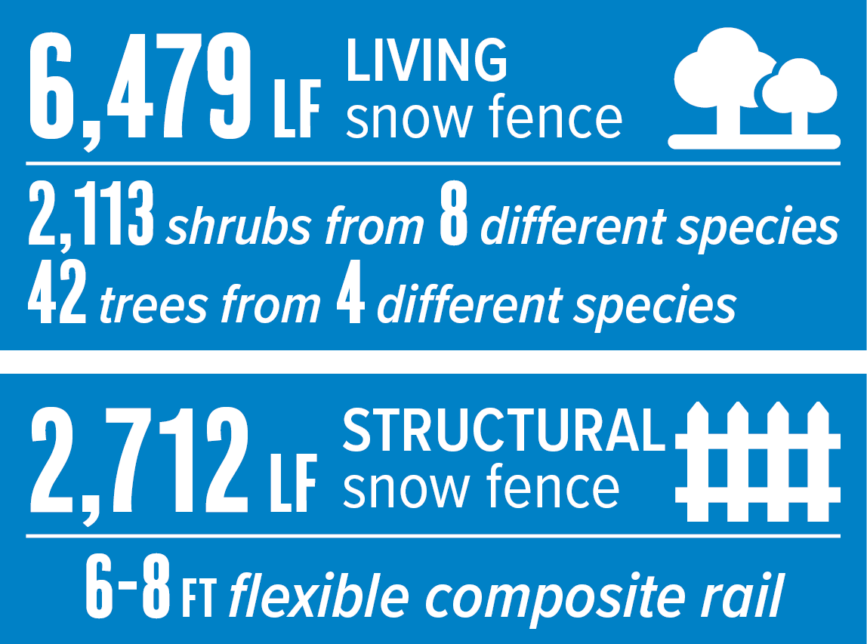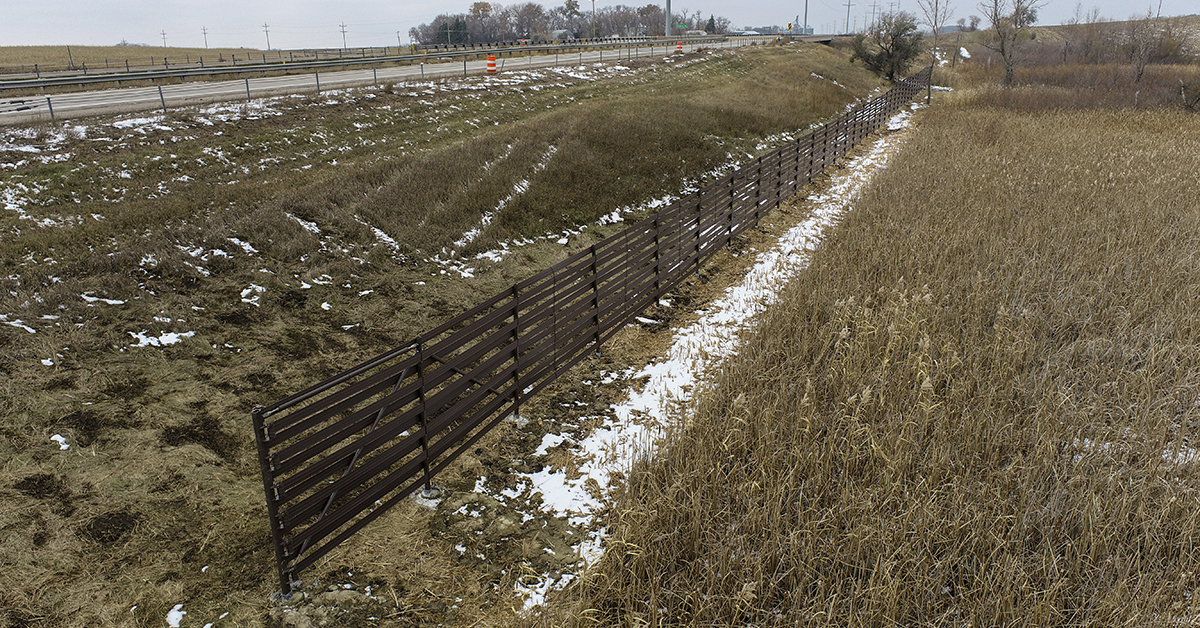Impacts of Snow Fence Design
You may have noticed fence structures and planted vegetation popping up along various highway rights-of-way in Minnesota during the last several years. What you might be seeing are snow fences, one of the many ways the Minnesota Department of Transportation (MnDOT) combats blowing snow and icy roads in the winter. Now that winter driving is in high gear, snow fences are especially useful in addressing pesky blowing snow problem areas.
With numerous areas of flat and open terrain in MnDOT’s District 4 (west central Minnesota), plow operators and engineers sometimes need to be creative. The traditional technique of applying salt and sand doesn’t always work in areas prone to high winds – either the material blows away before it can penetrate the snowpack or ice on the road, or it melts the affected area, which refreezes before the surface can dry. When permanent structural or living snow fences are strategically placed in relation to topography, wind direction, and distance from the roadway, they can minimize issues by trapping the blowing snow before it even reaches the road surface.
Besides the immediate tangible safety benefits to motorists, snow fences and other blowing and drifting snow control measures make a difference in other ways:
- Saves local and state agency snow plow drivers time, resources, and the cost of material, ultimately saving taxpayers money
- Improves public safety
- Protects water resources and vegetation from overuse of salt, sodium chloride, and other chemicals
- Minimizes greenhouse gas emissions
- Contributes to overall sustainability of the road surface and infrastructure
- Provides economic benefits by reducing travel delays and road closures
Blowing snow control projects impact commerce and travelers every day by reducing the amount of snow that reaches the roadway and minimizing deteriorating road conditions. Investments in snow fences reduce crashes and the need for roadway closures while also decreasing environmental impacts and the cost of snow and ice removal.
Kohl Skalin, MnDOT District 4 Maintenance Superintendent
About this Project
Over the years, MnDOT’s highway maintenance crews have documented problem locations along their snowplow routes where blowing snow frequently causes the most severe conditions and crashes. Interstate 94 from Moorhead to Alexandria in District 4 often closes several times each winter due to dangerous road surfaces and reduced visibility from blowing snow. SRF recently partnered with District 4 to identify locations along that stretch that could be designed and installed as a single project.
SRF Project Manager Eric Laidley, PE, worked with MnDOT’s project manager and staff to explore potential snow fence solutions for 29 identified problem sites along I-94. The project team evaluated the following features at all sites while considering both structural and living snow fence solutions for each:
- Prominent wind direction
- Topography
- Snowfall and wind speed measurements at that location
- Presence of overhead power lines
- Species of existing trees or vegetation in adjacent area
- Right-of-way acquisition requirements
After review, the project team determined that six of the 29 sites did not require MnDOT to acquire additional right-of-way to meet design standards. Because right-of-way acquisition would require additional time and expense, the six sites without this requirement were chosen for this project.

Structural or Living Snow Fence?
Some basic factors were considered in the selection of the type of snow fence to be installed at each location:
- Structural snow fences can not be located under power lines
- Living snow fences are more desirable where the trees or shrubbery match into an existing tree line or landscape
- Analysis of existing road profile, backslope, and ditch
- Selection of trees or shrubbery dependent on MnDOT’s preference
How can SRF help?
SRF’s technical team of project managers, civil engineers, and technical analysts will work with your agency’s maintenance and engineering staff to carefully examine winter driving problem areas in your roadway network. Our team of experts will help you develop a plan to identify and address problem areas and reap the benefits of alternative blowing and drifting snow control solution. We are dedicated to helping agencies and communities achieve safe, cost-effective, and sustainable winter driving conditions on their roadways.

701.893.7423
Eric Laidley, PE, has more than 12 years of experience in transportation and traffic design. He has worked with state DOTs, counties, and municipalities on numerous complex rural highway and urban street projects as both a project manager and lead designer. Eric’s experience includes project management, snow fence analysis and design, rural and urban roadway design, interchange and roundabout design, client coordination, plans and specifications, permitting, cost estimates, and utility coordination.

